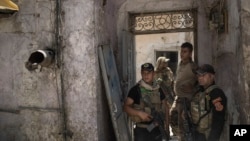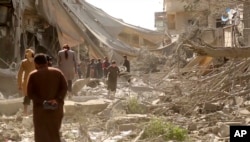With the Islamic State (IS) militant group on the verge of defeat in the Iraqi city of Mosul and surrounded by counter-Islamic State forces in the Syrian city of Raqqa, one question looms — where will the next major battle be?
Many U.S. military officials point to the Euphrates River Valley, namely Deir Ezzor province in Syria, and the area around the city of al-Qaim in Iraq. Those areas are not heavily populated like Mosul or Raqqa, but the fight could still prove incredibly difficult as multiple counter-Islamic State forces, with entirely different political agendas, converge on the region.
The counter-IS coalition has seen a steady stream of the terror group’s leaders try to move into swaths of the Euphrates River Valley, Pentagon spokesman Army Col. Ryan Dillon said Thursday. The last five coalition strikes targeting high-level IS leaders were conducted in the Muyadin and Abu Kamal areas of Deir Ezzor province.
Dillon would not say, however, whether the area has become the new center of the so-called Islamic State caliphate.
“There is no hub anymore,” he told reporters. “They are on the run, and we will not allow them to regroup and catch their breath.”
Training opposition groups
U.S. Central Command spokesman Major Josh Jacques told VOA the United States has been training two vetted Syrian opposition groups to fight IS in southeastern Syria.
Those two Syrian tribal groups are Maghawir al-Thawra (MaT) and Shohada al-Quartayn (ShQ), whose homelands include the Qalamoun Mountain region, the Euphrates River Valley and the Hamad desert, which stretches from the Jordan border north along the Iraqi border to the Euphrates River.
Both groups are supported under Section 1209 of the 2017 National Defense Authorization Action. In addition to first aid, clearing and marksmanship training, the coalition has provided MaT and ShQ with small arms, land navigation tools and medical supplies.
“I won’t go into specifics for operational security reasons, but the coalition’s two southern Syrian partner forces currently comprise a few hundred fighters. More are being recruited every day to help in the fight against ISIS,” Jacques told VOA, using an acronym for the militant group.
He added, “Vetted Syrian opposition groups all swear an oath to fight only ISIS, uphold the law of armed conflict, and respect human rights.”
But that oath to fight only IS could prove problematic for the future of Syria’s lower Euphrates River Valley.
Some members of these two groups are Syrian army defectors who have no interest in working with Syrian President Bashar al-Assad.
Al-Tanf army base
Meanwhile, Iranian-directed, pro-Syrian forces have positioned themselves between the al-Tanf army base, where the coalition is training Maghawir al-Thawra and Shohada al-Quartayn fighters to defeat Islamic State, and IS-held territory in the Euphrates River Valley.
“I think that the only way to get to [the Deir Ezzor provincial city of] Abu Kamal right now, if that were something that was even on the table, it would have to be from a different direction or different location,” coalition spokesman Dillon told reporters recently.
Michael O’Hanlon, a senior defense fellow at Washington-based Brookings Institution, said the U.S. and Iran are now in direct competition for certain access points inside eastern Syria.
“We don’t necessarily want that for ourselves, but we don’t want it for Iran,” O’Hanlon said.
Iranian leaders sense an opportunity to create a continuous land bridge that would span from Iran to the Mediterranean, and the Syrian government wants to retake the oil-rich lands in Deir Ezzor province.
Dillon and other military officials have said the United States would welcome pro-Syrian forces moving in to defeat Islamic State in Deir Ezzor province and would deal with any necessary military conflicts at a later date.
“Right now the focus is on Raqqa, and we’ll have to see what happens after Raqqa and where there are still ISIS fighters that remain,” Dillon said.
But O’Hanlon said the United States does not need to issue open invitations to Assad to be anywhere in eastern Syrian, because Assad is an illegitimate leader who has lost the faith of many inside Syria.
“The Sunni populations are not going to tolerate Assad’s regime being in control of an area like Raqqa or Deir Ezzor, so if it’s Assad who liberates it, or if it’s Assad’s allies ... it’s just going to be a guarantee of a Sunni attack down the road,” O’Hanlon said.











